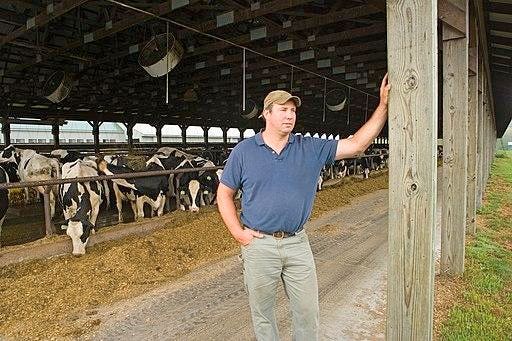A Connecticut dairy farmer, thinking about what he’s going to do with all the manure his herd is … [+]
The idea of “renewable natural gas” is almost laughable. Who would think that fermenting a foul-smelling pile of poop could generate a valuable stream of natural gas? In an article about the Barstow Longview Dairy Farm, a 200-year-old operation in Massachusetts, I described the tool that converts the farm’s manure to natural gas as a “mechanical stomach.”
In the renewable energy world, mechanical stomachs are given the less lyrical name of “anaerobic digesters.” According to the American Biogas Council, around 2,300 facilities are producing biogas in the U.S., of which around 530 are anaerobic digesters on farms.
The mere idea of using organic farm waste as a feedstock to produce an energy source was revolutionary for its time, and I am grateful that the 2,300 extant biogas facilities are helping to offset the demand for fossil hydrocarbons.
That said, anaerobic digesters have some weaknesses. Digesters are not very efficient at extracting energy from decaying organic matter–the energy they do extract is better than nothing, but a lot of energy-rich matter is simply not converted. Antibiotics fed to cattle to treat disease also wreaks havoc on a digester’s operations and can drop efficiency even more.
After whatever gas has been harvested, a solid called “digestate” must be cleaned out of the digester and disposed of. This digestate can be used to fertilize crops but contains high levels of nitrogen and phosphorus that can bleed into the local water table if overapplied to crops.
Also, as was true for the Barstows, capital costs for a digester are high and operating costs of maintaining the facilities can be high. For many farms, the added complications and expense of anaerobic digesters make them a non-starter.
This is why my ears perked up when I heard a pitch for the Colorado-based start-up W2E Renewable Solutions at a meeting of the Keiretsu Forum. I joined a voluntary due diligence team to dig into W2E’s technology and found that the company offers an interesting technical and business solution to both farmers looking to manage waste streams and companies seeking to lower the carbon intensity of their operations.
W2E’s facilities produce renewable natural gas without the weaknesses of anaerobic digesters
W2E’s president, Chris Webb—a co-founder and longtime waste management executive—realized that by processing manure in a certain way, it was possible to generate large amounts of energy-rich gas.
Webb tells me that the first step in the W2E process is to create syngas which can be burned to generate electricity directly or refined into green hydrogen and sold to an off-taker (i.e., a counterparty that signs a long-term purchase agreement). Off-takers looking for natural gas are also in luck because the syngas can also be converted into that fuel and transported to market via the extensive natural gas pipeline system.
Webb and his co-founder, John Wallace (W2E’s current chairman) built a team of engineers, energy executives, and industrial gas experts and designed a system to operationalize Webb’s insights. The system they designed allows them to manufacture various energy rich outputs using the same manure input.
A W2E facility uses off-the-shelf equipment—the company’s “secret sauce” is not in the tools to do the job, but in the process by which the job gets done. Using commercially available equipment lowers the venture’s technology risk, keeps costs down. and makes it easy to modularize facilities to adjust to the volume of input feedstock and the requirements of the off-taker.
A process diagram for the W2E reactor system. All the equipment is commercially available, lowering … [+]
From a farmer’s perspective, W2E’s solution provides some relief to very real pain points. Manure management is costly, especially for large dairies, because farms must meet local and federal environmental regulations. W2E pays farmers for their manure, turning the farmer’s cost center into a revenue producer. Also, unlike anaerobic digesters, W2E’s process does not generate digestate, saving farmers from the hassle and cost of digestate management.
The only byproducts of W2E’s process are char—a chemically stable form of nearly pure carbon that can be applied to fields to increase water retention, added to cement, or applied to other industrial uses—and carbon dioxide, which can be captured and stored.
W2E is in the midst of certifying its char as an industry-approved “supplemental cementitious material” for use in concrete (see this article to learn more about the SCM market). Webb plans to supply local highway and other infrastructure projects with char from local farms. Adding char cuts the carbon intensity of the cement and may actually strengthen the concrete.
While farmers represent one set of W2E’s clients, the company also sells its renewable natural gas to off-takers who want a low-carbon-intensity product to offset the carbon footprint of fossil fuels. For every cubic meter of gas W2E produces, the company can generate high-quality carbon credits that are easily measurable and auditable, unlike, for example, nature-based credits from forestry projects. The audit trail makes W2E’s credits attractive from the perspective of a large buyer (think Microsoft or United Airlines).
W2E plans to maintain the intellectual property for the facilities at a holding company level and fund local projects separately with project sponsors. As the technology becomes well-accepted, the firm will transition to a pure license-based model, generating high margins for the Holdco.
Because I signed a non-disclosure agreement with the company as part of the due diligence, I cannot report the profits projected for each facility but suffice it to say that they got my attention.
The math is simple: We must somehow cut our dependence on fossil fuels and foreign energy sources, and less fossil natural gas must be fracked for every cubic meter of renewable natural gas W2E produces. Intelligent investors take note.




